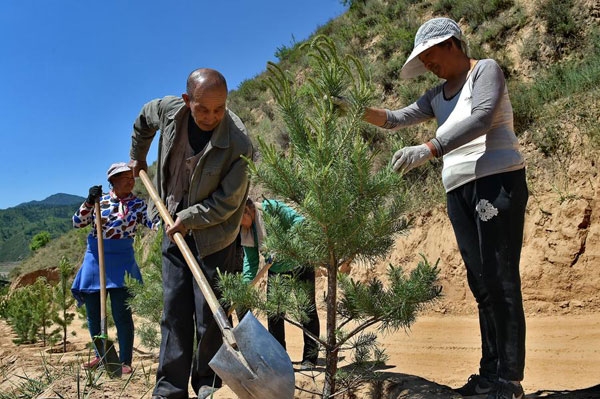當(dāng)前位置: Language Tips> 雙語新聞
The Lush Billion-Tree Spectacle of China's Great Green Wall
分享到
多年來,我國一直開展植樹造林,希望可以有效遏制荒漠化趨勢(shì)。英國籍馬來西亞攝影師鄭永仁(Ian Teh)穿越中國北方,用他的視角記錄下了這一驚人的壯舉。
 |
| 已被沙漠逼近的甘肅省敦煌市陽關(guān)鎮(zhèn)邊緣的綠洲。新華社記者 戚恒 攝 |
A desert doesn't sound like the most promising place to plant a tree. Yet, since 1978, China has planted at least 66 billion of them across its arid northern territories, hoping to transform its sandy steppes and yellow dunes into a Great Green Wall.
沙漠聽上去不像是最理想的種樹之地。但是自1978年以來,中國已在干旱的北方地區(qū)栽種了至少660億棵樹,希望能將沙質(zhì)草原和黃色沙丘改造成綠色長(zhǎng)城。
Ian Teh documented this epic undertaking while traveling through northern China last year. His expansive photographs show workers tending saplings, filling irrigation tanks, and blasting young trees with water. “Planting trees sounds great on paper, but you can feel skeptical,” Teh says. “But in person, it was impressive.”
鄭永仁去年穿越中國北方,記錄下了這一驚人的壯舉。他拍攝了大量的工人管理樹苗、給灌溉水車注水和給小樹澆水的照片。他說:“從理論上說,種樹是好事,但是你可能產(chǎn)生懷疑。不過親眼目睹后令人難忘。”
 |
| 工作人員在塞罕壩機(jī)械林場(chǎng)植樹(2014年5月13日 新華社記者王曉攝)。 |
The tree-planting strategy is a massive attempt to help fight desertification. Roughly a million square miles of China—a quarter of the country—is covered in sand. Drought, deforestation, overgrazing and other problems threaten an additional 115,000 square miles, fueling brutal sandstorms that regularly blast cities like Beijing and Dunhuang. Many scientists are skeptical planting trees will make a difference in the long run. But China’s State Forestry Administration claims the measure has reduced sandstorms by 20 percent and desertification by nearly 5,000 miles in recent years.
這個(gè)植樹造林的戰(zhàn)略是幫助戰(zhàn)勝荒漠化的宏大嘗試。中國大約有100萬平方英里(約合260萬平方千米)的土地為黃沙覆蓋,占國土面積的四分之一。干旱、森林采伐、過度放牧等等問題威脅著另外11.5萬平方英里的土地,引發(fā)的嚴(yán)重沙塵暴經(jīng)常肆虐北京和敦煌等城市。很多科學(xué)家懷疑種樹從長(zhǎng)遠(yuǎn)來看是否能有很大作用。不過中國國家林業(yè)局表示,這一舉措近年來使沙塵暴減少了20%,荒漠化土地減少了近5000平方英里。
 |
|
嵐縣會(huì)里村村民賈引民(左前)在種樹。截至2016年底,山西省已組建扶貧攻堅(jiān)造林專業(yè)合作社2188家,吸納貧困勞力5.5萬人,完成購買式造林15萬余畝。廣袤的黃土地上,一座座荒坡披上了“綠裝”,越來越多像賈引民一樣的貧困戶脫下了“窮帽子”,過起了好日子。 新華社記者 曹陽 攝 |
Teh lives in Malaysia but works throughout Asia, documenting humans’ impact on the landscape. Over six days in May 2016, he photographed tree-planting schemes in the Gobi Desert in northern China. They seemed successful in places like Duolun County, some 220 miles north of Beijing, where the government has planted 2.6 million trees over the past 17 years. The place felt pastoral, almost lush. Teh had to stop his car on the side of the highway and hike several minutes over dunes just to see where the wind-blown grass ended and the sand began. “To be honest, it was hard to imagine it was ever a desert at all,” he says.
鄭永仁住在馬來西亞,但是工作在亞洲各地奔波,記錄人類對(duì)地表的影響。在2016年5月份的6天中,他拍攝了中國北部戈壁沙漠的植樹造林計(jì)劃。在北京以北約220英里處的多倫縣等地,植樹造林計(jì)劃似乎取得了成功,過去17年政府在那里植樹260萬棵。那個(gè)地方一派鄉(xiāng)野風(fēng)光,草木茂盛,他不得不在公路邊上停下車,徒步走幾分鐘,翻過沙丘,看看在風(fēng)中搖曳的草的盡頭和沙漠開始的地方。他說:“老實(shí)講,難以想象這里在過去是沙漠。”
For contrast, he also flew some 800 miles southwest to the Tengger Desert, one of the places in China most affected by desertification. Outside the city of Wuwei, farmers struggled to work the dry soil. "It’s incredible to see them tilling land and everything around is dusty," he says.
為了對(duì)比,他還乘飛機(jī)向西南方向飛行約800英里到騰格里沙漠,那是中國荒漠化最嚴(yán)重的地區(qū)之一。在武威市郊區(qū),農(nóng)民在干旱的土地上艱難地耕作。他說:“看到他們?cè)谀抢锓N田,而周圍卻是黃沙漫漫,令人難以置信。”
來源:連線雜志網(wǎng)站、參考消息網(wǎng)
編審:yaning
上一篇 : 麥當(dāng)勞設(shè)手機(jī)專用寄存柜
下一篇 :
分享到
關(guān)注和訂閱

關(guān)于我們 | 聯(lián)系方式 | 招聘信息
電話:8610-84883645
傳真:8610-84883500
Email: languagetips@chinadaily.com.cn